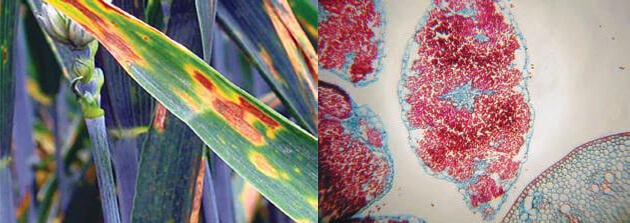Seed borne viruses and pathogens can cause devastating damages to crops, which is a big threaten to sustainability and marketability. Seed health testing, aiming for ensuring seedling establishment and minimizing pathogen transmissions, is an essential approach to prevent crop losses caused by pathogens and diseases.
 Figure 1. Infections of Ustilago nuda caused loose smut of barley leaves (left); and a microscopic view of the embryo infection (right) (Elias et al., 2012).
Figure 1. Infections of Ustilago nuda caused loose smut of barley leaves (left); and a microscopic view of the embryo infection (right) (Elias et al., 2012).
Lifeasible offers seed health testing services against viruses and pathogens. Our experienced scientists and crop specialists will not only help you with high-quality experiments with reliable results, but also offer professional consultations to help you make the best decisions for seed health of your crops. A variety of testing methods for seed health are available at our company.
- Field inspection. Pathogen infections can be detected during the growth of seed crops. A significant advantage of field inspection is that several diseases can be checked at one time.
- Visual examination. Pathogens or fungal structures accompanying the seed lot, internal tissues, or loosely attached to the seed coat can be identified by naked eyes or microscopes.
- Incubation tests. For incubation tests, aliquots of the seed sample extractions are cultured in a dilution series on a selection medium for the target pathogen. The identity of the target pathogen can be determined by biochemical, serological, or DNA tests.
- Grow-out tests. In this test, seeds are planted in a pathogen-free environment. After a certain period of growth, pathogen infection symptoms caused by the seedborne pathogens can be detected.
- Indicator tests. Extracts of seeds are used to inoculate healthy seedlings or mature plants. The pathogen is identified according to the symptoms developed on the inoculated plants.
- Phage-plaque tests. For this testing method, phage is used to lyse specific bacteria on solidified agar. At the presence of target bacteria, colonies will be lysed and develop plaques that can then be visualized.
- Serological diagnostic techniques. This technique utilizes specific antibodies, which are made by injecting an animal with a pure culture of the pathogen, to detect the target pathogen, and/or to quantify the antibody-antigen complex. The latter can be achieved in several ways, such as agglutination, agar precipitin, immunofluorescence, immunosorbent dilution plating, enzyme-linked immunosorbent assay (ELISA) testing.
- DNA techniques. Both DNA hybridization and PCR techniques can be used for the detection of target pathogens.
With cutting edge technology and optimized testing methods, we are devoted to meeting the needs for seed health testing from all of our customers. Our experts can not only help you precisely to identify plant disease (s) and their corresponding pathogens, but also will provide you with professional advices for your decisions on the growth and marketing of your crops.
Reference
- Elias, S. G., Copeland, L. O., Mcdonald, M. B., and Baalbaki, R. Z. (2012). Seed Testing: Principles and Practices. Michigan State University Press.
For research or industrial raw materials, not for personal medical use!
 Figure 1. Infections of Ustilago nuda caused loose smut of barley leaves (left); and a microscopic view of the embryo infection (right) (Elias et al., 2012).
Figure 1. Infections of Ustilago nuda caused loose smut of barley leaves (left); and a microscopic view of the embryo infection (right) (Elias et al., 2012).